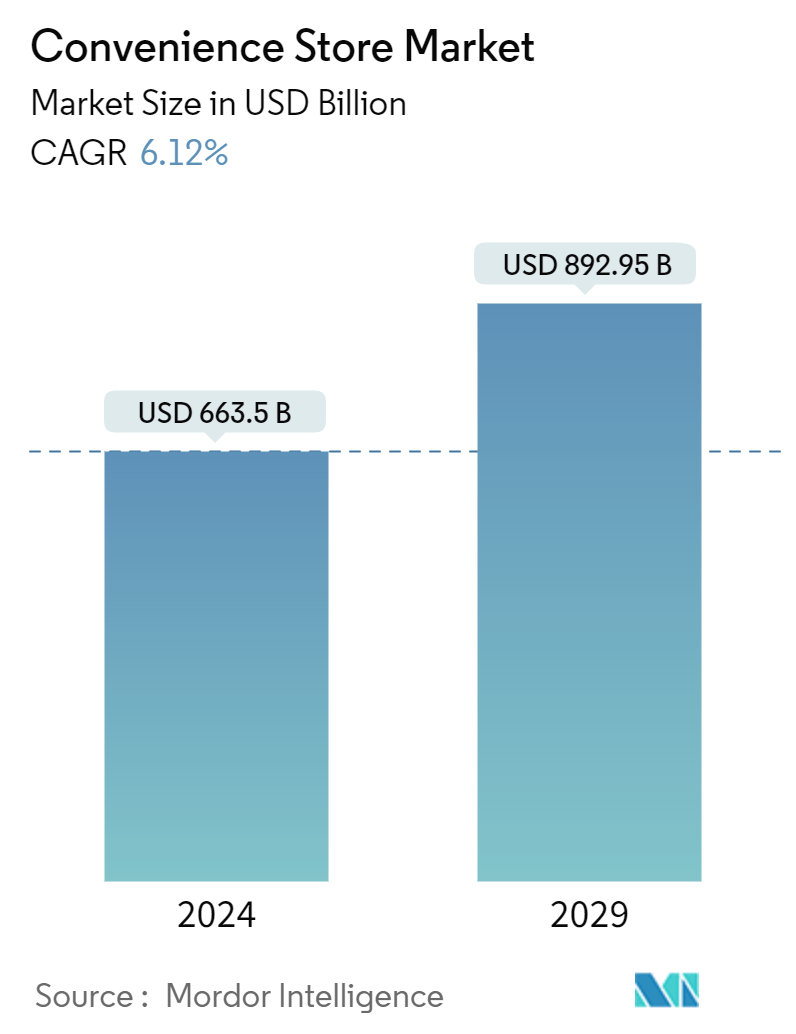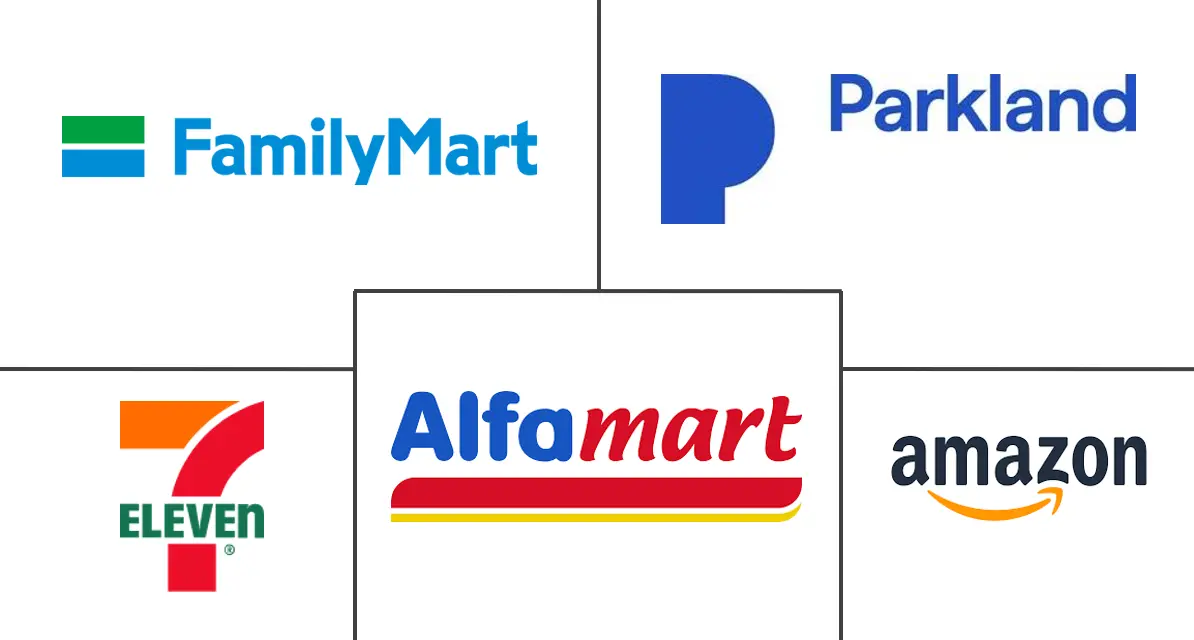Market Size of Convenience Store Industry

| Study Period | 2020 - 2029 |
| Base Year For Estimation | 2023 |
| Market Size (2024) | USD 663.5 Billion |
| Market Size (2029) | USD 892.95 Billion |
| CAGR (2024 - 2029) | 6.12 % |
| Market Concentration | Low |
Major Players
*Disclaimer: Major Players sorted in no particular order |
Convenience Store Market Analysis
The Convenience Store Market size is estimated at USD 663.5 billion in 2024, and is expected to reach USD 892.95 billion by 2029, growing at a CAGR of 6.12% during the forecast period (2024-2029).
The global convenience store industry is expanding, meeting the demands of time-pressed customers who appreciate easy access to necessities and convenience. Convenience stores are ubiquitous across nearly all nations, providing diverse products and services. In many countries, convenience stores are an integral part of daily life. They allow people to grab snacks, beverages, basic groceries, and other daily necessities without visiting larger supermarkets. The extended operating hours of convenience stores make them accessible even during evenings and weekends when other stores may be closed.
The global population and population density are continuously rising; existing retail convenience stores are rising to meet the increasing demand. A convenience store provides easy access to products from nearby stores, and with some stores opening 24 hours a day, customers can access their products when needed. One of the critical advantages of convenience stores is their strategic locations. They are often found in residential areas, near transportation hubs, or in commercial districts, facilitating their easy accessibility to a diverse clientele. In recent years, technology has also had a big impact on the convenience store industry. Some stores have implemented self-checkout systems, contactless payment options, and mobile apps for seamless shopping experiences.
Convenience Store Industry Segmentation
A convenience store is a retail shop that makes available essential goods consisting of groceries like eggs, bread, butter, and milk, over-the-counter medicines, soft drinks, etc., with a few convenience stores selling limited alcohol products.
The convenience store market is segmented by product types, store types, and region. By product types, the market is sub-segmented into staple products, impulse products, and emergency products. By store types, the market is sub-segmented into kiosks, mini convenience stores, limited selection convenience stores, traditional convenience stores, expanded convenience stores, and hyper convenience stores. By region, the market is sub-segmented into North America, Latin America, Europe, the Middle East and Africa, and Asia Pacific.
The report offers market size and forecasts for the convenience store market in value (USD) for all the above segments.
| By Product types | |
| Staple Products | |
| Impulse Products | |
| Emergency Products |
| By Store Types | |
| Kiosks | |
| Mini Convenience Stores | |
| Limited Selection Convenience Stores | |
| Traditional Convenience Stores | |
| Expanded Convenience Stores | |
| Hyper Convenience Stores |
| By Region | |
| North America | |
| Latin America | |
| Europe | |
| Middle East and Africa | |
| Asia-Pacific |
Convenience Store Market Size Summary
The convenience store market is experiencing significant growth, driven by the increasing demand for accessible and time-saving shopping options. These stores are strategically located in residential areas, near transportation hubs, and commercial districts, making them easily accessible to a diverse customer base. The extended operating hours, often 24/7, cater to consumers' needs for convenience, especially during evenings and weekends. The integration of technology, such as self-checkout systems and mobile apps, has further enhanced the shopping experience, attracting more customers. The market is characterized by a diversification of product offerings, including fresh food and healthier options, which align with changing consumer preferences and the demand for nutritious choices.
In the Asia-Pacific region, the convenience store market is witnessing substantial growth due to rapid urbanization and the rising purchasing power of the middle class, particularly in countries like China and Vietnam. The proliferation of convenience stores is supported by improved infrastructure and collaborative agreements among local businesses. Independent convenience stores are emerging globally, contributing to increased foot traffic as they offer fresh products. Major players in the market, such as 7-Eleven, Family Mart, and Alfamart, continue to lead with significant market shares. Recent acquisitions, like those by 7-Eleven and Casey's General Stores, highlight the ongoing expansion and rebranding efforts within the industry, further driving market growth.
Convenience Store Market Size - Table of Contents
-
1. MARKET DYNAMICS AND INSIGHTS
-
1.1 Market Overview
-
1.2 Market Drivers
-
1.3 Market Restraints
-
1.4 Industry Value Chain Analysis
-
1.5 Industry Attractiveness - Porter's Five Forces Analysis
-
1.5.1 Bargaining Power of Buyers
-
1.5.2 Bargaining Power of Suppliers
-
1.5.3 Threat of New Entrants
-
1.5.4 Threat of Substitutes
-
1.5.5 Intensity of Competitive Rivalry
-
-
1.6 Insights of Technology Innovations in the Market
-
1.7 Impact of COVID-19 on the Market
-
-
2. MARKET SEGMENTATION
-
2.1 By Product types
-
2.1.1 Staple Products
-
2.1.2 Impulse Products
-
2.1.3 Emergency Products
-
-
2.2 By Store Types
-
2.2.1 Kiosks
-
2.2.2 Mini Convenience Stores
-
2.2.3 Limited Selection Convenience Stores
-
2.2.4 Traditional Convenience Stores
-
2.2.5 Expanded Convenience Stores
-
2.2.6 Hyper Convenience Stores
-
-
2.3 By Region
-
2.3.1 North America
-
2.3.2 Latin America
-
2.3.3 Europe
-
2.3.4 Middle East and Africa
-
2.3.5 Asia-Pacific
-
-
Convenience Store Market Size FAQs
How big is the Convenience Store Market?
The Convenience Store Market size is expected to reach USD 663.5 billion in 2024 and grow at a CAGR of 6.12% to reach USD 892.95 billion by 2029.
What is the current Convenience Store Market size?
In 2024, the Convenience Store Market size is expected to reach USD 663.5 billion.

